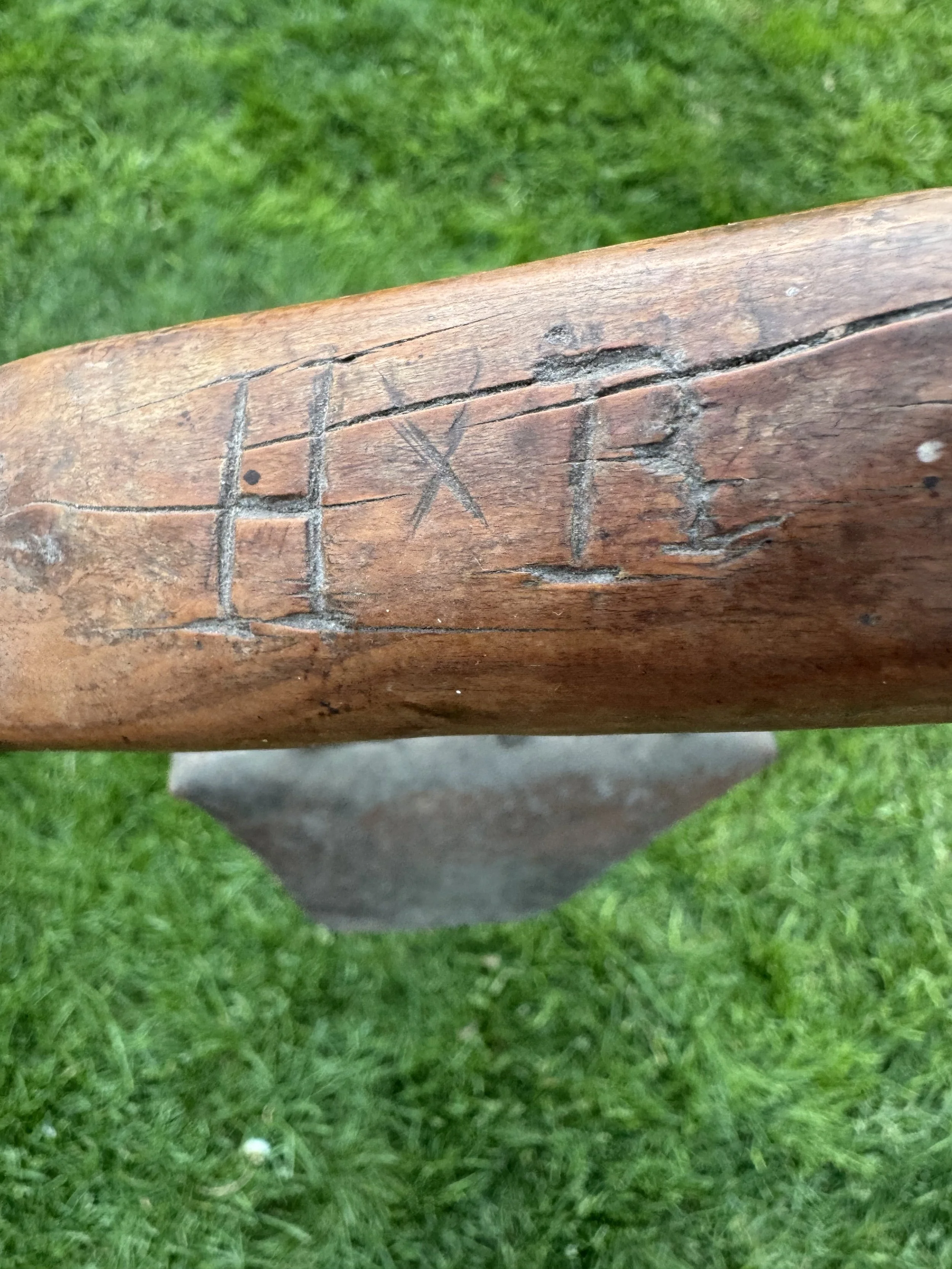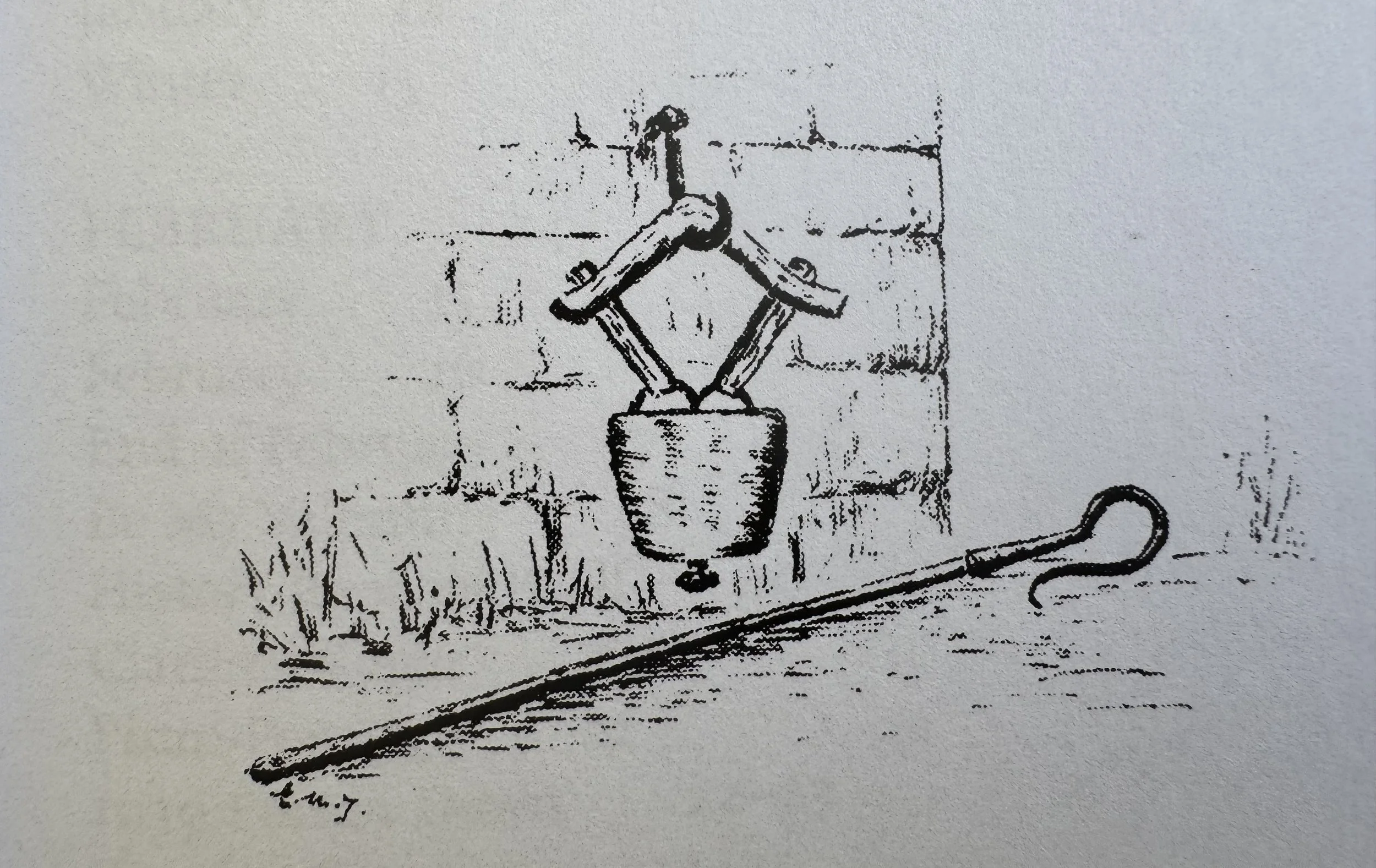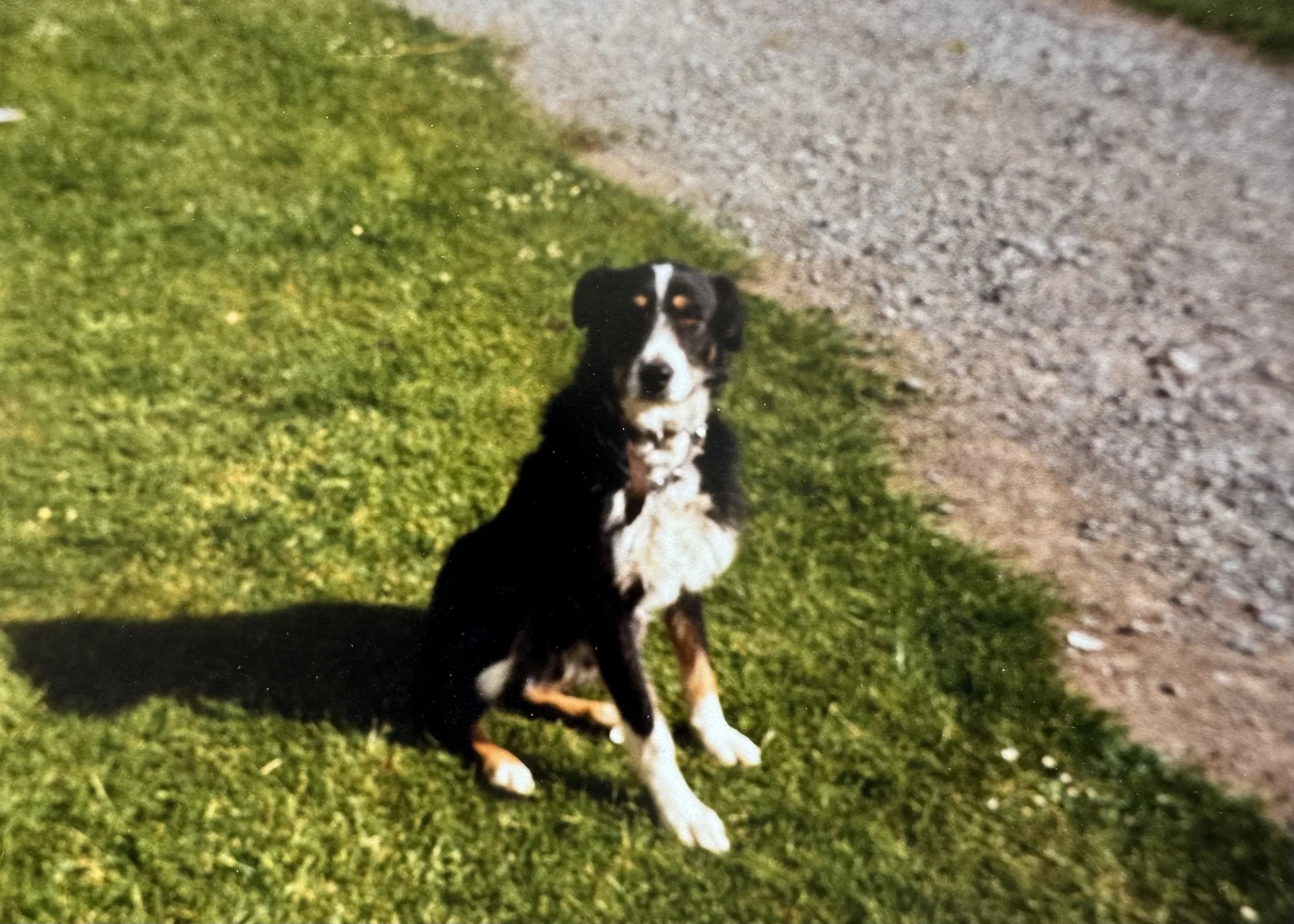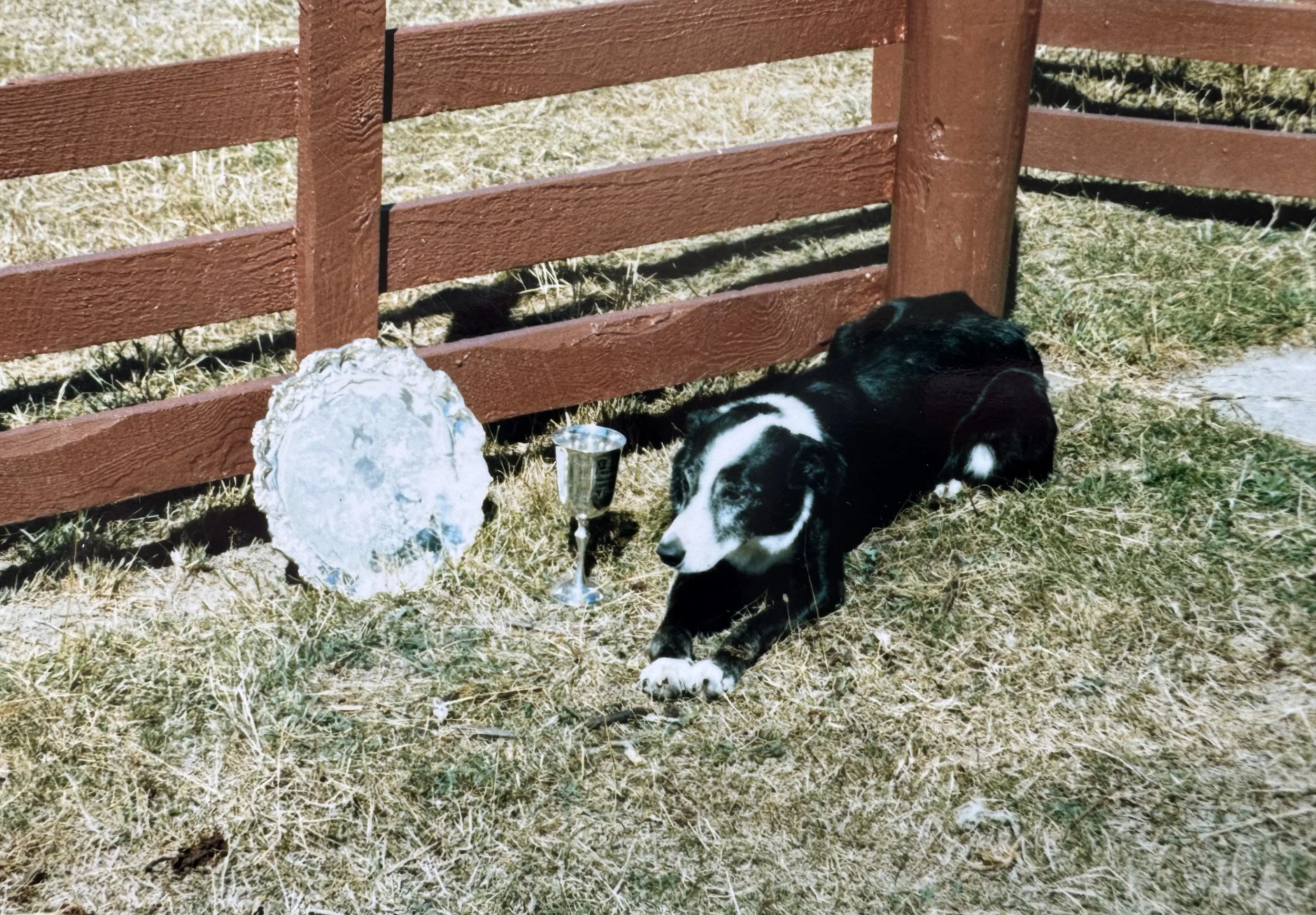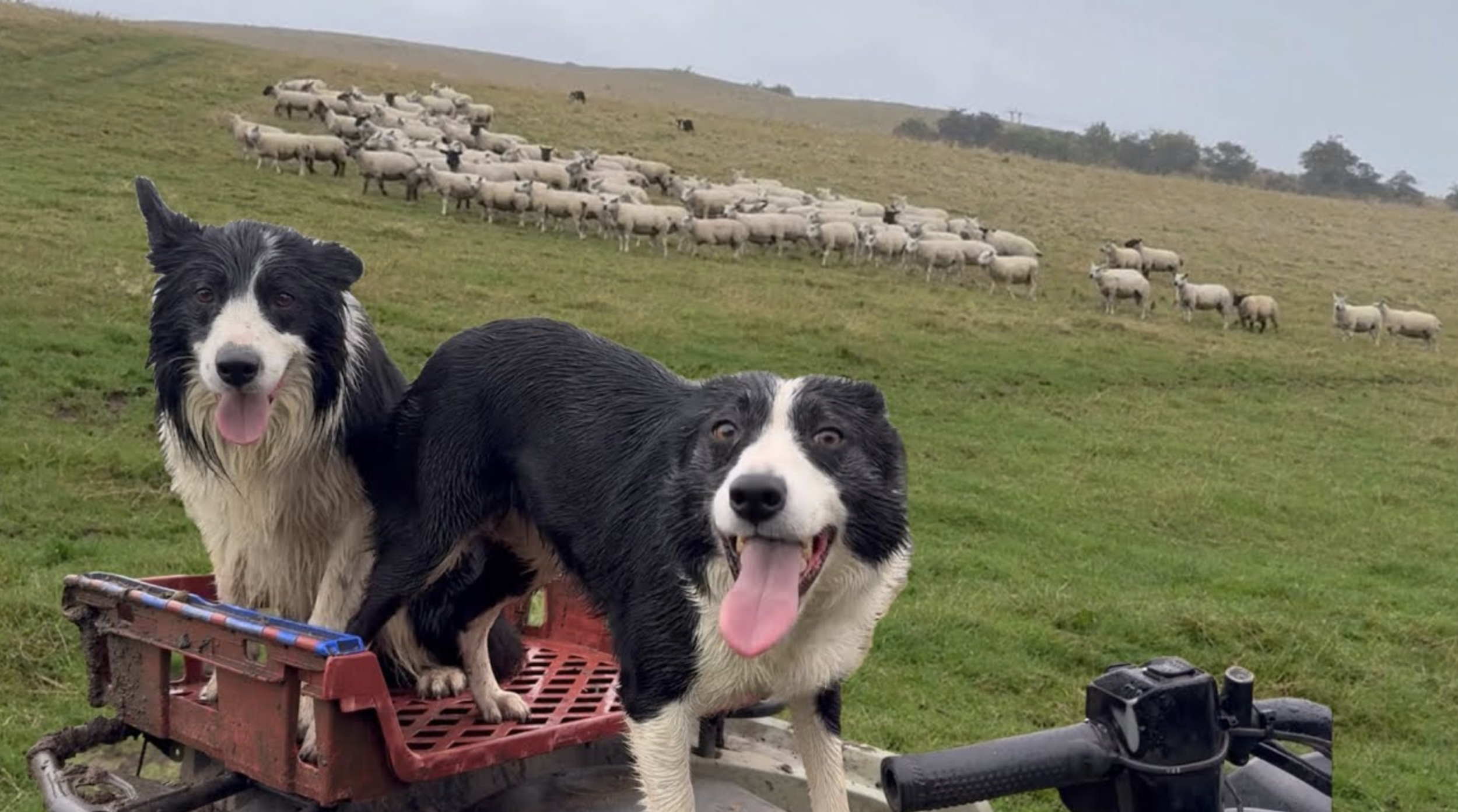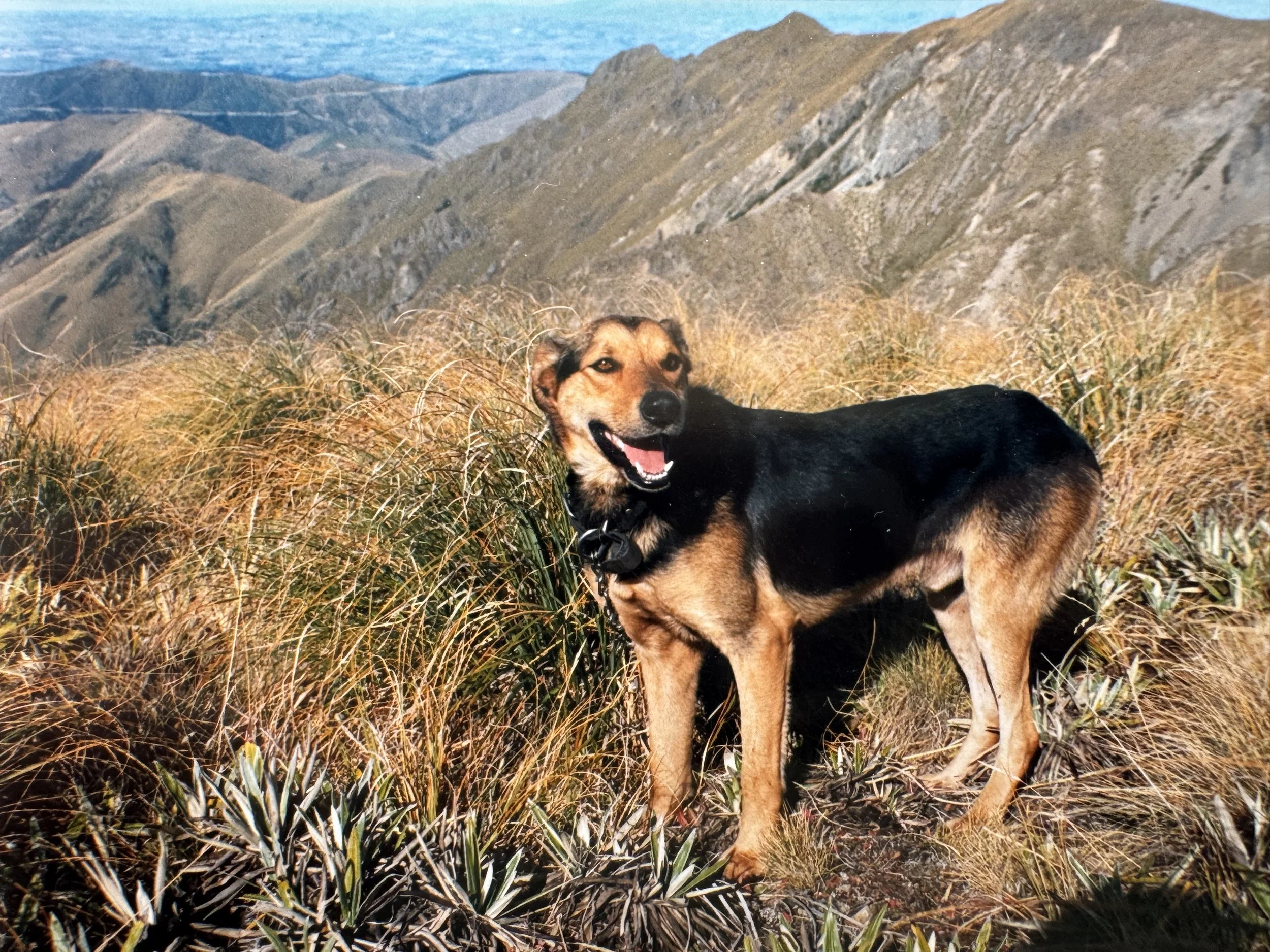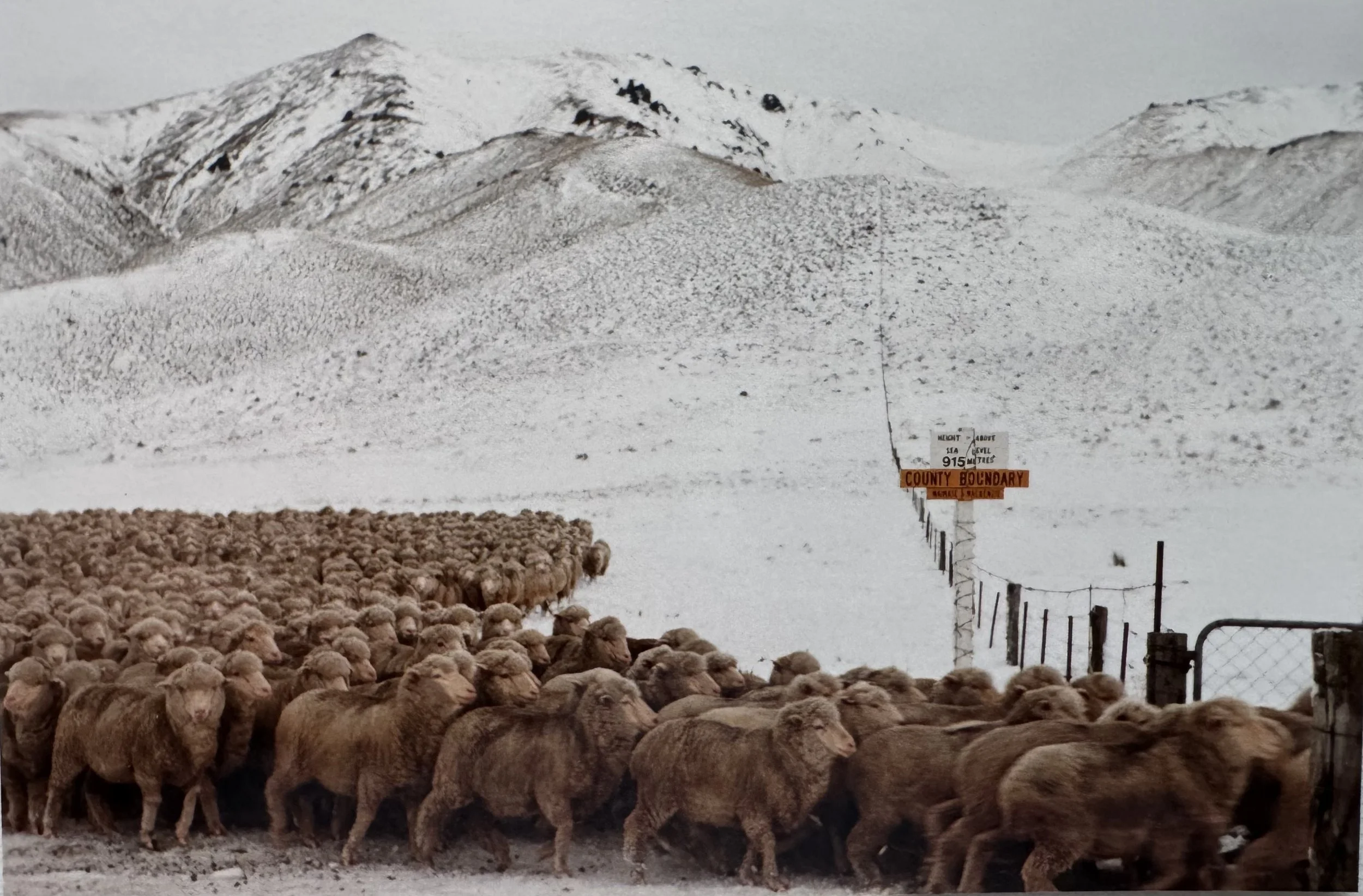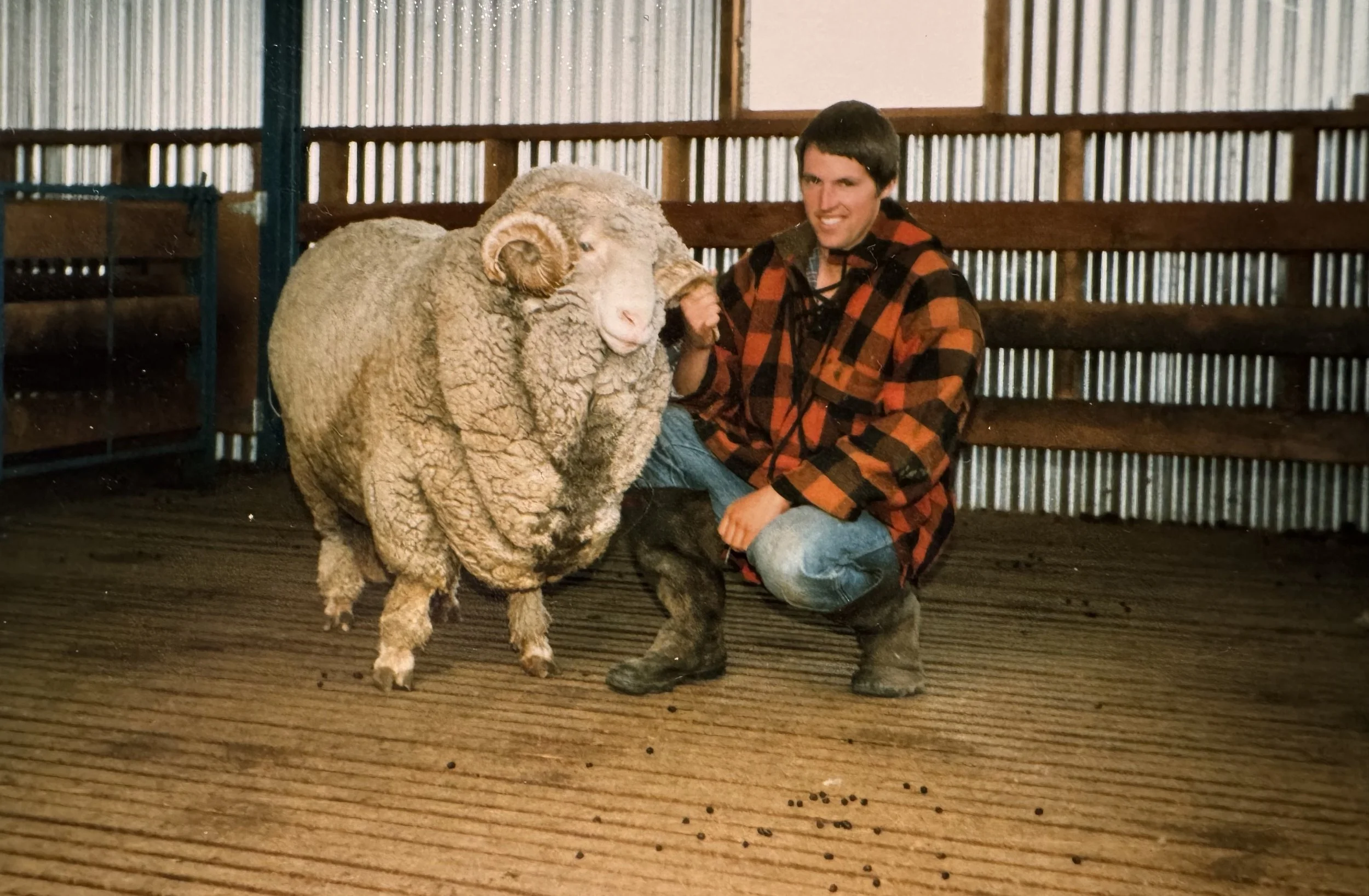The Cannister Bell
It hangs from a beam on my porch now, weathered and worn: a squat, rusted canister bell with a voice like memory. It came from Wiltshire, a gift from my aunt, Ann, Lady Blakiston, who was once a shepherdess during the war years when all the men were away. She worked the hills of Wiltshire with a crook in one hand and the weight of the land in the other, and brought with her a lifetime of stories: folk tales thick with dew, thick with the kind of truth that only oral history dares tell.
The bell itself is carved with the date 1877 and the initials HR. Whoever that was, I like to imagine he (or she) walked the chalk downs above the Wylye Valley with a few hundred Dorset ewes, and a dog that knew its business. There’s something in the heft of the bell that speaks of labour, of honest days and cold mornings, of lanolin-slick fingers and the wind off Salisbury Plain. The clapper still rings, sharp and metallic, a sound that would carry far over heather and bracken. It’s a sound that sheep come to know: half warning, half lullaby.
In Wiltshire, sheep bells weren’t just tools. They were talismans. Each flock might have just one or two—“leaders’ bells” they were called—hung around the necks of the lead ewes to help the shepherd keep track of his mob in fog, mist, or the failing light of an English dusk. In valleys where the mist pools like water and every hill looks the same, the bell was a lifeline. A way to find your sheep when sight failed and instinct took over.
There’s a Wiltshire tale my aunt used to tell about bells. She claimed that in the days before enclosure, when the land was open and the shepherds knew every blade of grass by name, bells weren’t just for sheep. They were for spirits, too. At lambing time, when the boundary between life and death seemed thinnest, bells were rung not only to locate ewes, but to ward off the “lantern men.” These ghostly figures wandered the downs with lights in their hands, luring lost shepherds to their doom.
“If you heard two bells in the night,” she said, “one was yours, and the other… wasn’t.”
She also believed each bell held a kind of memory. That you didn’t own a bell so much as inherit it. That it rang with all the places it had been and all the sheep it had followed. That’s the sort of thing you smile at when you’re young, and come to believe when you’re older.
Wiltshire itself is sheep country through and through. Before tanks rolled over Salisbury Plain, before Stonehenge was cordoned off behind ropes and placards, it was a place of flocks. Drovers moved their mobs from Devon to London, through the old drove roads of Pewsey Vale and Savernake Forest, resting at chalk-cut watering holes and weather-worn pubs. Bells would clang through village lanes at dusk, and every local could tell by the sound whether the flock was heavy with wool or lean with travel.
The bell that hangs on my porch came through that lineage. A lineage of people who knew how to move quietly, how to listen to the weather, how to count sheep not for sleep but for survival. Aunt Ann was one of those. One of the last, perhaps.
Sometimes, when the wind hits it just right, the bell rings: not loud, just a faint, metallic note in the afternoon breeze. It sounds like a summons. Or a remembering. And each time I hear it, I think of Wiltshire, of Aunt Ann’s stories, of the wartime shepherdess who wore gumboots over stockings and carried her lunch of lardy cake in a nummet bag. I think of the initials HR, carved into the bell with some pocketknife long ago. I think of flocks disappearing into fog. And the soft, certain sound of a bell leading them home.
This pencil sketch of the bell was done in 1986 by E.M. “Betty” Jeans, sister of Ann Blakiston.
The Shepherd’s Dogs
One of the first dogs I ever owned was a scrapper called Mac. It was November 1981. I was a green new-chum shepherd at Grampians, still figuring out what wayleggo meant. Mac fancied himself as a bit of a fighter; he thought he could take on anything on four legs. Unfortunately, his career in the canine fight game was short-lived.
One afternoon, he decided to pick a fight with Storm, Stuart Falconer’s big black-and-tan huntaway. Storm wasn’t just bigger; he was older, meaner, and knew exactly what he was doing. The outcome was about as predictable as a mutton race. Mac went in full of bark and bluster and came out with a nasty hole in his head.
Because he couldn’t reach it to lick, the wound festered and swelled until he looked like he was growing a second skull. The other shepherds, never short of wit or cruelty, christened him “Pussnut.” It stuck. For years, that name followed him across the hills like an echo. But Mac was a tough old boy. He recovered, scar and all, and from then on he picked his battles more carefully: usually with sheep.
Mac…not a fighter.
That was my first real lesson in shepherding: every dog, no matter how brave, learns humility sooner or later. And in a way, that’s what makes them such extraordinary companions.
For as long as shepherds have walked the hills, dogs have walked beside them: partners in patience, courage, and the occasional foolishness. Their history stretches back millennia, to when early herders first noticed that the wolves hanging around the campfires could be persuaded to work for a living. From that uneasy truce came the most significant working partnership in history: man and dog, mind and instinct, whistle and bark.
Every shepherd knows the feeling of watching a good dog at work—the way it moves with quiet intent, crouched low, reading both sheep and master. There’s no need for words. A whistle, a glance, and the job’s done.
Jill, my heading dog, with trophies that she won at the Burke’s Pass Dog Trials, 1987.
I’ve had many dogs since Mac, each with their quirks, tempers, and triumphs. Some barked too much, some thought too much, and a few, like Mac, mistook bravado for brains. But every one of them shared the same heartbeat—the same devotion to the job, the same bond that has tied shepherds and dogs together since before the first fence was built.
The truth is, shepherding without dogs would be like fishing without water. They make the work possible, and more than that, they make it worthwhile. They remind you that intelligence comes in all shapes: sometimes with four legs, a cold nose, and a ridiculous nickname you’ll never live down.
🐑🐑🐑🐑🐑🐑🐑
In every shepherd’s story, there are dogs. Faithful, cunning, and uncomplaining, the sheepdog has been part of the shepherd’s life for thousands of years; long before crooks and quad bikes, before fences, before plastic whistles and GPS.
Archaeologists have found the bones of herding dogs beside their masters in Neolithic graves, their remains suggesting a partnership already ancient by the time the first flocks grazed the highlands of Britain. From the Middle East to Mongolia, from the Pyrenees to New Zealand’s Mackenzie Country, the pattern repeats: shepherds and dogs, side by side, reading each other’s minds in the language of work.
A good dog is more than a helper. They are an extension of the shepherd’s will: seeing what their master cannot, moving with an intelligence that feels half instinct, half intuition. Together they form a single working mind, divided only by distance and whistle.
Border Collies, Wales.
The bond between shepherd and dog is unlike any other. It’s forged in weather and work; long days on the hill or in the desert, wet and wind-blown, hot and thirsty, where a nod or a glance says more than a dozen words. There’s pride in a well-cast dog, in the way it circles the mob with that low, wolfish run, or crouches, eyes locked, until the sheep turn and yield.
Across the centuries, countless breeds have emerged from this shared labour: the wiry little Welsh Collie, the lithe Bearded Collie of the Highlands; the stalwart Huntaway of New Zealand, bred not for silence and stealth but for sound, a booming bark that moves thousands. In Andalusia, the Perro de Agua guards flocks against wolves; in Turkey, Kangals stand guard beneath the stars; in the Atlas Mountains of Morocco, the Aidi keeps the flock safe from jackals; and on the steppes of Mongolia, the great Bankhar dog sleeps beside the herder’s yurt, ever watchful.
Kangal sheepdogs, Turkey.
Yet no matter their shape or voice, they carry the same inheritance: loyalty, endurance, and the quiet joy of purpose. Every shepherd has a dog story. Dogs who saved a drifting mob in the fog, or brought a runaway ewe down from the cliffs of Snowdonia. Dogs who outsmarted belligerent rams on the Canterbury Plains, dodged hooves on the red soils of Andalusia, and worked until they could barely stand on the peaks overlooking the Black Sea. Dogs who refused to be left behind in the dust of the Outback, or in the snowfields of the Caucasus.
These stories are the truest measure of a shepherd’s life. Because behind every tally, every muster, every long droving route, every hot day in the yards, every desert morning, every campfire on the Mongolian steppe, every snowbound night in the Caucasus, every wind-swept hill in Wales, every dawn call to prayer echoing across the deserts of Jordan, and every thunderstorm rolling over the plains of Central Queensland, a dog is watching, waiting, ready to work again.
Bounce, Four Peaks Station, 1994.
Introduction to The Shepherds
It all begins with an idea.
I am a shepherd.
There. I’ve said it.
I am a shepherd.
Being a shepherd is a bit like being a surfer. Or being in the Mafia. Or a being ordained as a monk. Once you're in, you're never really out. The life stays with you. It shapes how you move through the world. And although more than a quarter of a century has passed since I last walked the muscular hills and ridges of the High Country on New Zealand’s South Island, with dogs at my heels and a manuka stick in my hand, the imprint of those years remains as clear to me as the tracks on a snow slope.
It’s a young man’s calling, shepherding. I began at eighteen. As I grew older, I moved on—seeking new places, new pursuits—but the qualities I gained from that life have never left me. Resourcefulness, independence, and self-reliance. To be observant. To have an eye for weather, and a respect for solitude. These are not just skills; they are ways of being. And now, as my TikTok feed fills with the sights and sounds of shepherds from Turkey, Kazakhstan, Arabia, Wales, China, Morocco, Scotland, Georgia, Spain and New Zealand—ShepherdTok, I call it—I find myself once again drawn into that world I once inhabited. A world I never really left.
Merino wethers crossing the Hakataramea Pass, Grampians Station, 1986.
So I’ve come back: not as a shepherd this time, but as a witness. A chronicler. A traveller with a dog whistle still hanging on a lanyard around my neck, a small token of a life once lived and never truly left behind.
I am not returning to muster sheep this time. I am coming back to gather up stories. I want to walk along the ridgelines of my memory, and the mountain paths and desert trails walked by other shepherds. I want to revisit my former life as a shepherd with the clarity that only age and distance can bring. I want to examine what I did in those far off days, who I was, and how being a shepherd shaped who I became.
But this journey is not mine alone. I want to explore the ancient world of shepherds; men and women who walked before me, crook in hand, through the pages of history and scripture. From the hills of Judea to the fells of Cumbria, from the Mesta trails of Spain to the steppes of Central Asia, shepherds have long stood as figures of resilience, watchfulness, and quiet authority.
And more than anything, I want to connect with shepherds across the world today. To hear their voices, learn their rhythms, and understand the land through their eyes. Whether herding flocks in the Atlas Mountains, minding ewes in the Pamirs, or watching over mobs in the Welsh hills, these men and women speak a language I still recognise: a language of wind, of silence, of movement, and care.
This is my return. Not to the fold, but to the field. To walk beside shepherds once more. Across cultures, across time, and across the great, weathered face of the Earth.
The author with a prize-winning merino ram, Grampians Station, 1985.


